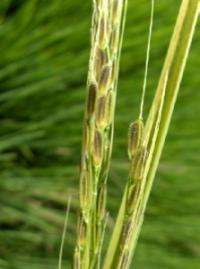To help rice farmers, geneticists study how nature produces a weed

As rice farmers across the south prepare to plant their crop this month, University of Massachusetts Amherst evolutionary geneticist Ana Caicedo and a research team are beginning a major new study of how weeds evolve in general and of weedy rice in particular, one of the prime threats to rice production worldwide and in the United States.
This basic research into the genomic structure of the aggressive species known as red or weedy rice could lead to new ways of controlling invasive plants that now cause crop losses worth billions of dollars annually worldwide, and threaten a basic food staple relied upon by millions.
Along with research leader Caicedo (pronounced Kai-sedo), the team includes others at UMass Amherst plus investigators at the Dale Bumpers National Rice Research Center in Arkansas and Washington University in St. Louis. The work is supported by a nearly $2.5 million grant from the National Science Foundation.
One of Caicedo’s specific contributions will be to sequence and compare the full genomes of cultivated and weedy rice. Previous work has shown that weedy rice in the United States likely descended from common cultivated rice groups, which makes it an ideal model for understanding the genetic changes by which weediness emerges in agricultural settings, Caicedo explains. "I’m very excited about sequencing the weedy rice genome and learning from this how evolution can produce a weed from a domesticated ancestor."
Like many weeds, red or weedy rice is more aggressive than cultivated rice and has several undesirable characteristics. For example, it ripens at widely varied times instead of all at once like cultivated rice, and it disperses or scatters its ripe seeds rather than retaining them on the plant until they can be harvested. This last trait is particularly difficult for farmers, so Caicedo will try to identify the genes she suspects are controlling it. Making the task more difficult is that many strains of weedy rice have probably evolved over the centuries.
In fact, Caicedo and colleagues think two weedy groups have evolved independently just in the United States, and these groups may use different genes to control weedy traits. Work in the Caicedo lab has already shown that weedy rice does not carry the same mutations as wild rice’s that leads to seed dispersal. Like weedy rice, the wild ancestor of cultivated rice also disperses its seeds, but this trait evolved separately in the weed.
"Red rice seems to be using new genetic mechanisms to evolve rapidly and adapt itself to an agricultural environment, she says. "However, closer examination of the weedy rice genome may also reveal cases where weedy genes have been acquired through hybridization with other wild rice groups."
Once it is established, weedy rice is very hard to get rid of because it’s so much like the regular rice plant. Weedy rice has become established in many rice-growing regions in the world.
As a separate objective of the study, Caicedo and colleagues will determine how a weed’s origin and population structure compare in four major areas--South Asia, Southeast Asia, Northeast Asia, North America--where it commonly occurs. Each has a different predominant local cultivated rice variety and each differs in the presence or absence of reproductively compatible wild species. Regardless of differences, Caicedo says, "Anywhere you grow rice, red rice is a problem. We’ll look at the relationships between wild, cultivated and weedy rice from around the world and see in each case which types the weed is most closely related to."
Caicedo and colleagues will also assess how recent shifts in agricultural practices here in the United States toward use of imidazolinone herbicide-resistant rice varieties may produce an herbicide-resistant weedy rice. They will explore whether this happens via crop-to-weed gene flow or spontaneous mutation. "We hope to provide basic insights into the impact of recent shifts to herbicide-resistant rice farming on weed evolution," Caicedo notes.
The product known as "wild rice" is actually a different species of grass with edible seeds that is unrelated to weedy or cultivated Asian rice, native to the Great Lakes region.
Provided by University of Massachusetts Amherst
















